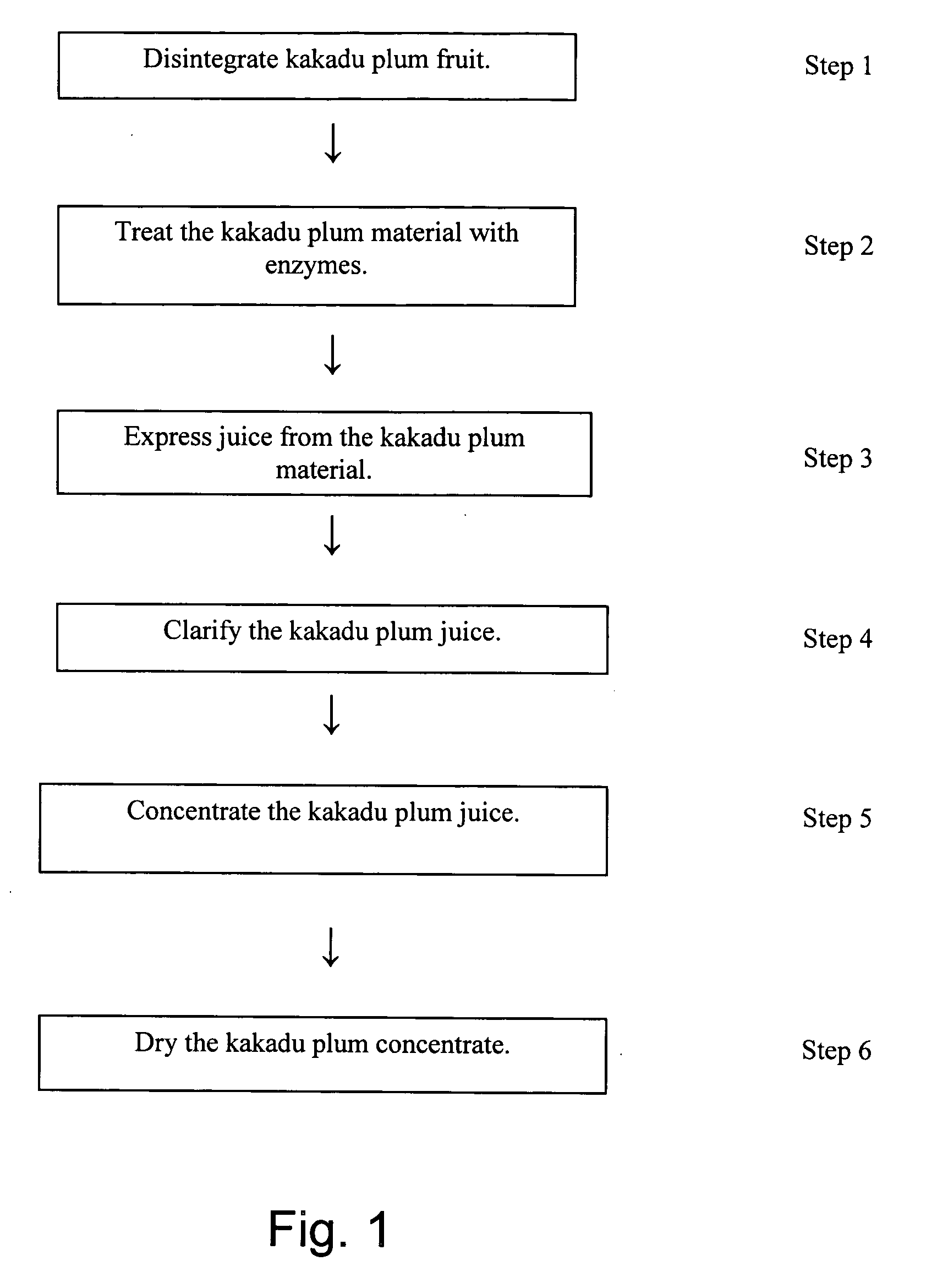Method of preparing kakadu plum powder
a technology of kakadu plum and kakadu powder, which is applied in the field of preparing kakadu plum powder, can solve the problems of affecting the final concentrate quality and yield, affecting the efficiency of processing and extraction of kakadu, and affecting the quality of final concentrate. and yield, and achieves the effect of reducing the cost of production
- Summary
- Abstract
- Description
- Claims
- Application Information
AI Technical Summary
Benefits of technology
Problems solved by technology
Method used
Image
Examples
example 1
[0043] This example was used to determine various enzymes ability to digest kakadu plum material, thereby reducing the viscosity of the matrix. Pitted kakadu plum fruit from 1998 and 1999 harvests was mixed with 1.5 kg water containing enzyme in a blender at maximum speed for two minutes. The blender used was a four-liter Waring blender commercially available from Waring Products, Inc. of McConnellsburg, Pa., U.S.A. Different 400 gram aliquots of the resultant mixture was placed in separate 1000 milliliter (ml) Erlenmeyer flasks maintained at 40° C. for 2 hours. After enzymatic digestion, the solids are separated from the supernatant liquid. A Sorvall centrifuge (Model RC-5B available from Sorvall Inc., Newton, Conn., U.S.A.) was used to separate the solids. The centrifuge was operated at 8500 rpms for 30 minutes. The liquid extracts reach ambient temperatures of about 23° C. to about 25° C. and the viscosity of the supernatant was evaluated to determine the effectiveness of the enz...
example 2
[0045] Kakadu plum fruit harvested in 2000 was milled with a Urschel mill with a 0.75 inch mill head. Water was added to the milled kakadu flesh at a 1:1 ratio (24 kgs water:24 kgs kakadu fruit (including seeds)). 60 ml of a solution of Biopectinase Super 7× was added to the mixture at a concentration of (0.5 ml enzyme to 100 ml of water) (1:200). Digestion is continued with adequate mixing for 2 hours at 43.3° C. (110° F.). The slurry is then pressed to separate solids from the soluble phase using a Reitz screw press having a 30-mesh (0.0234 inch) screen. Screw pressing the slurry at 6 rpms resulted in a well de-watered cake. The seeds in the cake were intact and whole. The 38.5 kgs of expressed juice was tested at 4.1% soluble solids. The resultant 9.0 kgs of de-watered cake had a moisture content of 49.9%.
example 3
[0046] Kakadu plum fruit harvested in 1998 was milled with a Urschel mill as in Example 2. Water was added to the milled kakadu flesh at a 1:1 ratio to yield 47.2 kg of slurry. With 60 ml of Biopectinase Super 7× added to the mixture at a concentration of 1:200, digestion is continued with adequate mixing for 90 minutes. The slurry is then pressed to separate solids from the soluble phase using a screw press having a 70-mesh 0.0083 inch screen. At 6 rpms, the cake de-watered well and the seeds were intact. The 47.2 kg of slurry produced 37.4 kg of expressed juice and 9.2 kg of de-watered cake having a moisture content of 49.9%. The soluble solids content of the expressed juice was 4.45%.
PUM
| Property | Measurement | Unit |
|---|---|---|
| viscosity | aaaaa | aaaaa |
| temperature | aaaaa | aaaaa |
| size | aaaaa | aaaaa |
Abstract
Description
Claims
Application Information
 Login to View More
Login to View More - R&D
- Intellectual Property
- Life Sciences
- Materials
- Tech Scout
- Unparalleled Data Quality
- Higher Quality Content
- 60% Fewer Hallucinations
Browse by: Latest US Patents, China's latest patents, Technical Efficacy Thesaurus, Application Domain, Technology Topic, Popular Technical Reports.
© 2025 PatSnap. All rights reserved.Legal|Privacy policy|Modern Slavery Act Transparency Statement|Sitemap|About US| Contact US: help@patsnap.com

